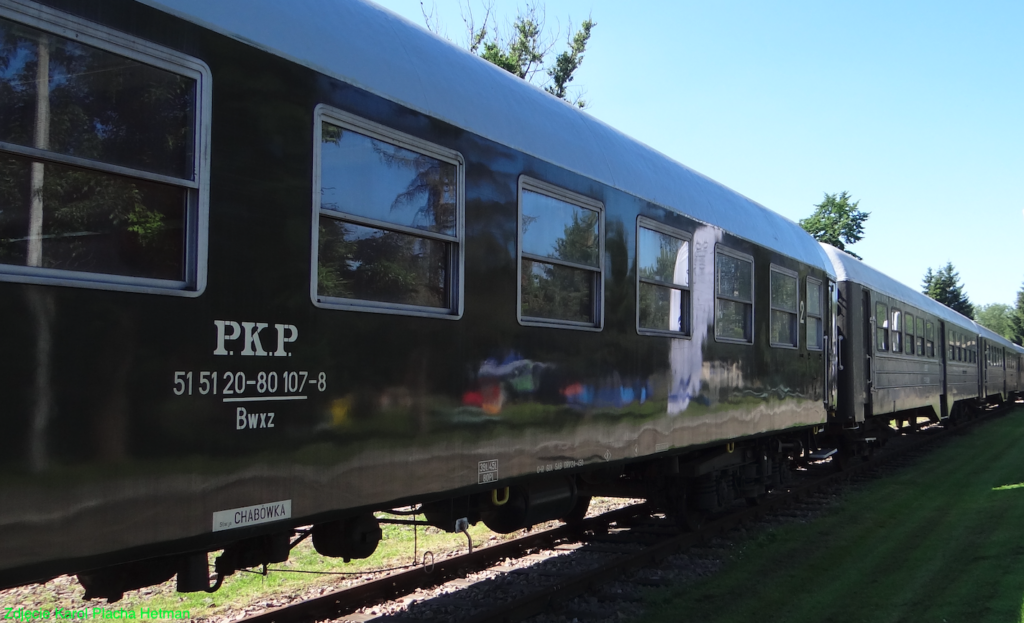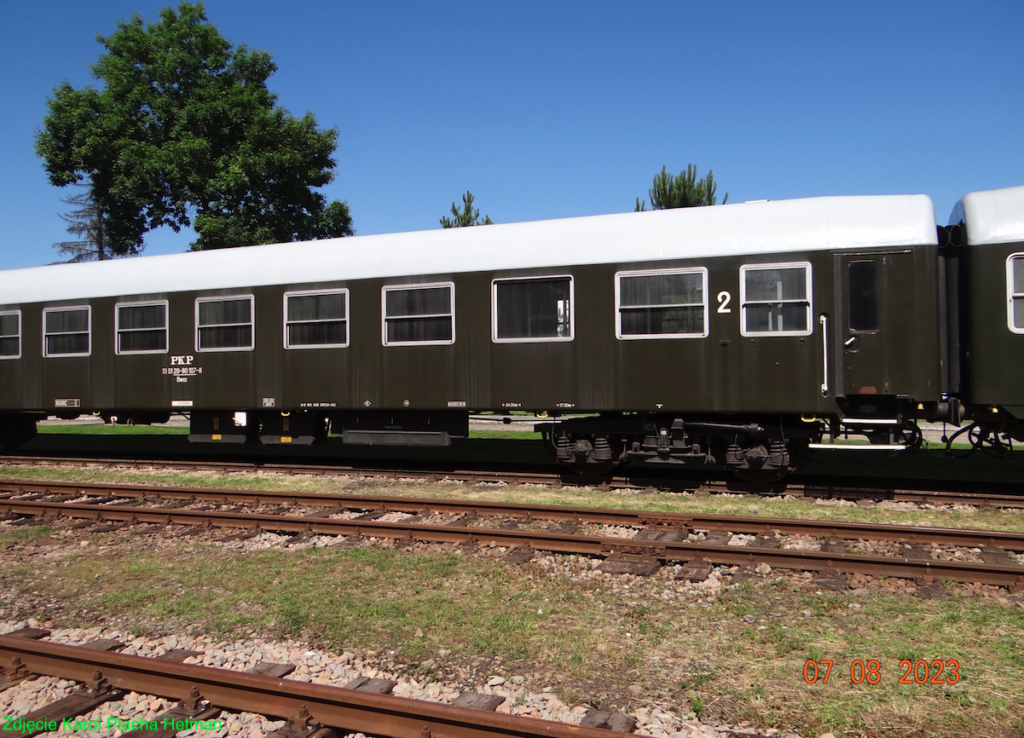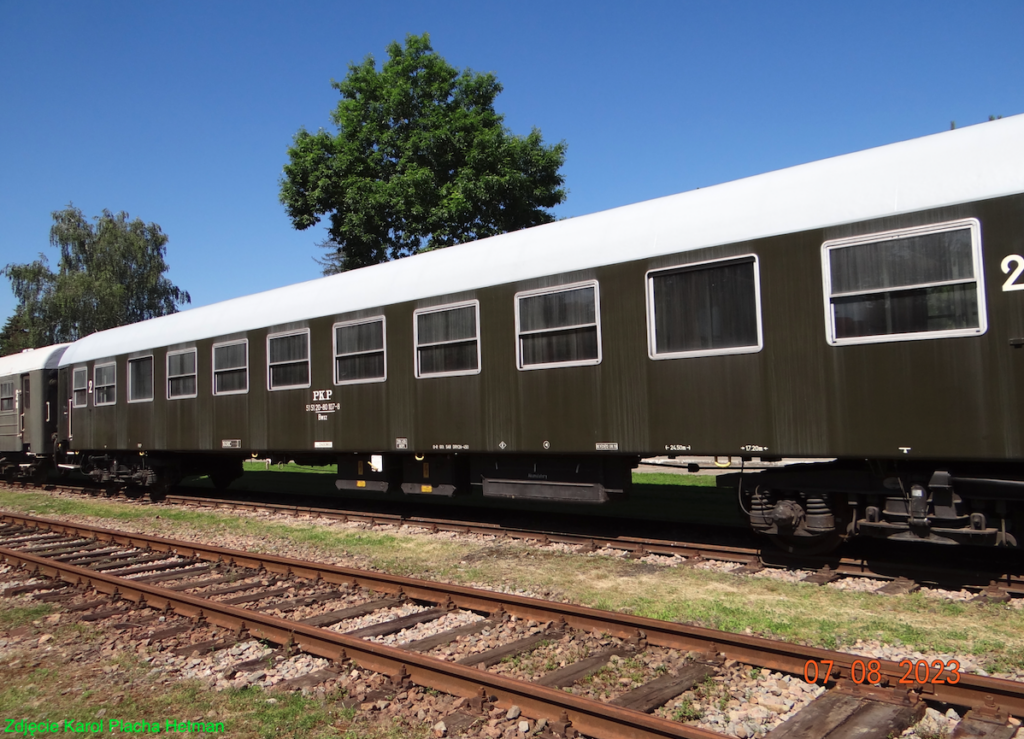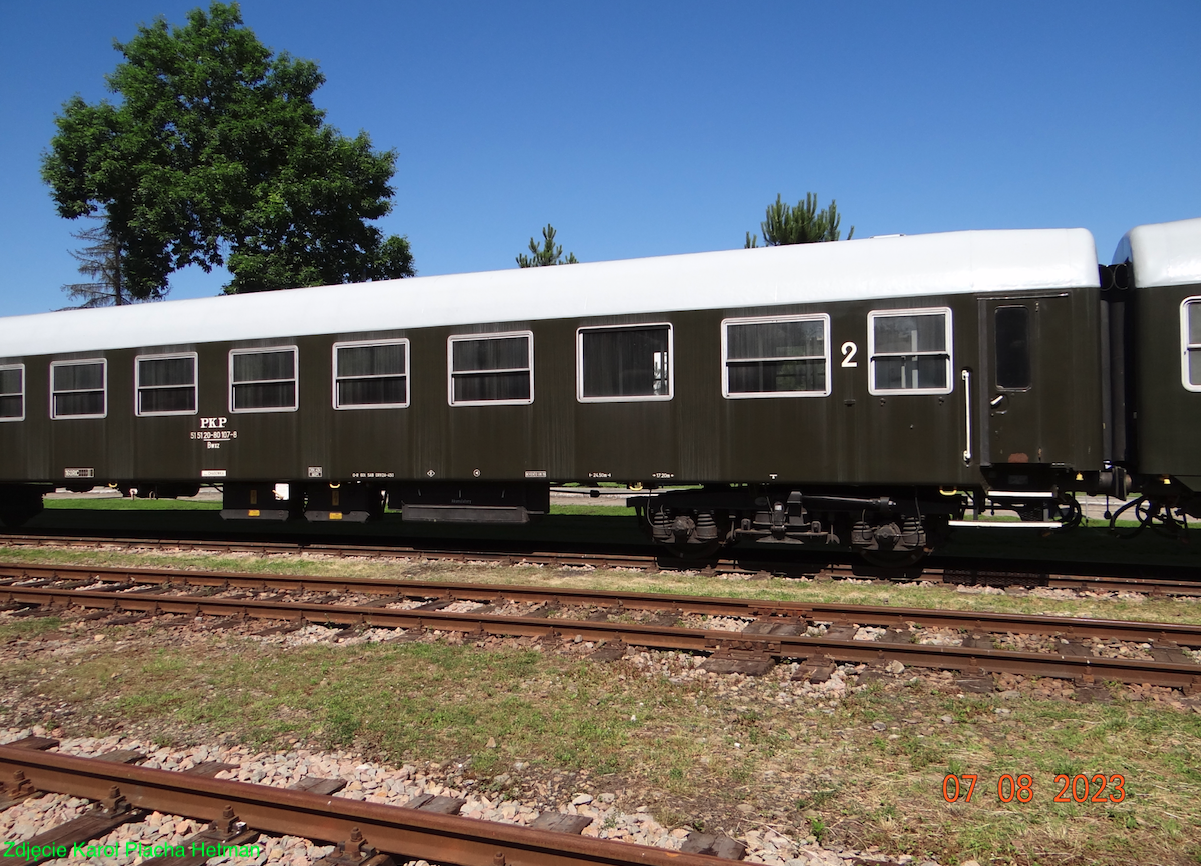Chabówka 2023-08-02
Passenger wagons type 111A. 1976.
Passenger wagon of the “Y” standard of Polish production type 111A, Bwxz, No. 51 51 20-80 107-8, manufactured in 1976, at HCP.



Photo description: Passenger car type 111A manufactured by HCP. Number 515120-80 107-8; 51 – fixed gauge, non-air-conditioned, 51 – PKP, 20 – passenger car 2nd Class, 80 – running speed 140 – 160 km/h, 107 – serial number, 8 – self-control digit. Marking Bwxz: B – 2nd Class, w – car with HV wire for high voltage, for electric heating, x – car with steam heating, alternative heating, z – declassed car. Passenger car type 111A; Bwxz, manufacturer HCP.
The car was developed as a development version of the 104A type car. The 111A type car was in production in the period 1969-1989, i.e. for twenty years. A total of 2,825 units were produced. This is the type of passenger car that was produced the longest and in the largest quantity. In addition to the HCP factory, these cars were produced by the PaFaWag factory. To date, about 1,500 units are in use, which have undergone minor or major modifications. At the time, these were very modern and successful Polish passenger cars.
Already at the end of the 19th century, national railway boards met with each other to unify standards for passenger cars in international traffic. Since these meetings were based on a discussion forum, everyone interpreted the guidelines in their own way. The first problem that was positively resolved was the track width in Europe. On standard gauge lines, it is 1,435 mm. At the beginning of the 20th century, the cars used were from 20 m to even 27 m long, which inevitably determined a smaller or larger number of compartments. Germany (FRG) introduced cars from 1951 that were later defined as the “X” standard. Their characteristic feature was the total length of 26.40 m and six-seater compartments, both in 1st Class and 2nd Class. The 2nd Class carriage had 12 compartments, while the 1st Class had 10 compartments. At the same time, other national authorities considered the “X” standard carriages to be too comfortable and less economical. Therefore, the “Y” standard was developed, which in 1961, was also adopted as a standard. The “Y” standard was adopted in France and the countries of the Eastern Bloc.
The distinguishing feature of the “Y” standard cars is the total length of 24.50 m. The 2nd Class cars have 10 passenger compartments inside, and each of them has 8 seats. The 1st Class cars have 9 compartments inside, and each of them has 6 seats.
The origin of the 111A type cars.
The prototype of the 111A type car is the 104A type car, developed in 1962 in Poznań. The 104A car was designed for a travel speed of up to 160 km/h. The prototype car was made in 1964 at the HCP plant. The cars were mass-produced until 1969. 80 units were built.
The car was characterized by folding entrance doors. The double-leaf inter-carriage doors were manually moved sideways. In 1978, production of the 104A type wagons was resumed and another 100 units were built. The 104A series wagons and their derivatives were designed as long-distance wagons, intended for domestic and international traffic.
In 1969, an improved 2nd Class passenger car was designed. It received the designation type 111A. In the literature, the manufacturer’s mark HCP or PaFaWag is often added. The 111A type car, depending on the used bogies, is designed for a speed of 140 or 160 km/h. The cars were produced (with breaks) from 1969 to 1989. Other sources say that until 1992. In HCP, 2nd Class passenger cars of the 111A type were built in the period 1969-1971 and 1976-1978. In the PaFaWag plants, they were produced in the period 1969-1992. Some sources say that production started already in 1967. A total of 2,825 units were produced, which makes the 111A type the longest series of cars in Poland. There are currently (2021) around 1,500 wagons in service, and many of them have undergone numerous modifications.
Exterior.
From the outside, type 111A wagons are distinguished by the number of windows: 10 full-size and 2 smaller ones in the toilets/vestibules. The windows in the toilets have frosted glass. There are also windows in the entrance doors. The roof can be grooved or smooth (PaFaWag). There can be a different number of vents on the roof of the wagon and their arrangement. The wagons differ in the handrails for boarding. The entrance to the wagon has three or two steps. The entrance doors are folding, much more convenient to open than single-leaf doors, although they are still opened manually. The bottom of the body has a rolled-up edge (PaFaWag) or straight (HCP). Some types of wagons use rolling bogies other than 4ANc.
The wagons were heated by steam and electricity. Since 1973, production of wagons (111Ac) equipped only with electric heating was undertaken. In the 1980s, electric heating was already installed – forced air. In 1984, the production of wagons with alternative steam heating was completely abandoned. Steam heating was used when the train was in steam or diesel traction (locomotives SU45, SU46).
All carriages in Poland were painted dark green. 1st Class carriages had an additional gold (yellow) stripe above the windows. The roofs were painted grey, and the bogies black. The PKP inscription was placed in the central place on the side of the carriage, and below it the digital designation of the carriage. Near the entrance door there was a number of the carriage class and possibly the information “Non-smoking carriage”, “Smoking carriage”.
Construction of the 111A carriage.
Type 111A is a 2nd Class carriage, in the body of which there were 10 compartments, and in each compartment there were 8 passenger seats, with soft benches. The seats were numbered. The entrances to the carriage are placed at both ends of the body, on both sides of the side. Additionally, double-leaf sliding doors were placed in the front walls, which allow passage to the next carriage.
In the carriage, at the ends there was one toilet. Each toilet is equipped with a window, the upper part of which is tiltable, for additional ventilation. The toilet has an open system toilet bowl, which is why you were not allowed to use the toilet at the station. There was hot and cold water in the sink. There was a liquid soap dispenser and a toilet paper holder and a dustpan by the sink. Locking the door from the inside of the toilet caused a red light with the word WC to come on in the corridor above the swing door. The corridor was accessed through swing doors, which were always closed when not in use. All you had to do was push the door slightly to get through. The doors were made of aluminum and glass. A heater was placed along the corridor, near the floor. On the side with windows, between them, there were folding chairs with thin upholstery. The chairs were for travelers for whom there was no room in the compartments.
Each compartment is accessed by manually sliding doors. The sofas are soft, upholstered in brown material with the PKP logo. Above the sofas are duralumin luggage shelves. Mirrors and pictures with landscapes are placed between the backs of the sofas and the shelves. The windows are covered with brown curtains with the PKP logo. Each compartment has lighting and heating controls. The control panel is located above the entrance door to the compartment. The car lighting was electric; fluorescent lamps. The entire interior is finished with aluminum alloy sections, glass and laminated boards. The car body is made of low-alloy carbon steel. The frame, side walls, front walls and roof are welded, creating a uniform self-supporting structure. The frame is made of bent C-sections from 3 mm thick sheet metal. The car frame is made of bent sections 2 – 3 mm thick. The body cover is made of 2 mm thick sheet metal. The corrugated roof is made of 1 mm thick sheet metal. Thermal and acoustic insulation was installed in the frame. The moisture and corrosion insulation was made of asphalt paints, with a coating thickness of about 1-2 mm. Additionally, polystyrene boards were used. The front walls of the wagon have rounded edges, for a streamlined shape. Full-size windows are made of aluminum alloys, divided into two parts; the lower part is fixed, the upper part opens downwards. The windows have single panes, 5 mm thick. During production, double panes were introduced. In the 1980s, some corridor windows had only one pane. The windows in the vestibules and toilets are smaller with a hinged upper part. The panes in the toilets are frosted.
Na ostoi położono sosnowe lub świerkowe belki, a na nich impregnowaną sklejkę o grubości od 15, 17 lub 19 mm. Na sklejce położone jest tworzywo winileum. Podłoga w toaletach jest wykonywana jako wanna z żywicy poliestrowej lub epoksydowej wzmocnionej włóknem szklanym. Ściany działowe zbudowano z wodoodpornej sklejką o grubości 8 – 10 mm. Jako wyciszenie i ocieplenie zastosowano filc i styropian. Jako wykończenie zastosowano laminat i aluminiowe lub plastikowe profile.
The gangways between the cars have double-leaf doors installed, which are manually pushed to the sides. From the outside, the doors between the cars are covered with rubber rollers. The cars have a classic screw coupling and classic buffers equipped with springs. The buffer stroke is 11 cm. Each end of the car is equipped with two electric red lights, and additionally with hooks for end-of-train signals. The front wall has high-voltage electrical connectors, brake system and steam heating system.
Interior finish.
The car has soft sofas in the compartments. Four passengers could fit on one sofa. The sofas had armrests on the edges and in the middle. Fabric upholstery. Initially in brown with patterns with the PKP logo. Above the sofas there were shelves for hand luggage and suitcases. Above the seats there were seat numbers. The windows were covered with brown and beige fabric curtains with the PKP logo. The walls were lined with boards made of hard decorative laminate of the Unilam type, with a wood structure. The compartment doors are manually pushed to the side. The corridor is covered with decorative laminate of the Unilam type. Folding seats between the windows. The carriage is lit with lamps equipped with fluorescent lamps. The floor is covered with hard linoleum (vinileum) 3-5 mm thick. The vinyl is welded at the joints. The corridor is separated from the vestibules by swing doors. Between the compartments and the corridor there are light walls made of waterproof plywood and 5 mm thick glass. The interior finish is dominated by aluminum alloys, in silver or gold. The strips cover the joints of the laminate boards and protect sharp edges.
Trailer bogies.
The wagons were equipped with 4AN type bogies. The two-axle bogie and with the wagon’s service weight of 39,500 kg, worked well. Travel speeds of up to 160 km/h were not a problem for the wagon and the run was smooth. Initially, an Oerlikon type braking system was used. The brakes are block type. Emergency brake levers were placed in the corridor inside the wagons and in each of the compartments. Each wagon was also equipped with a manual screw brake, activated from one of the vestibules using a wheel with a crank installed there. Over time, modernized 4ANc type bogies were installed. 4ANc type bogies were installed in some wagons even until 1992. There are also 4ANh, 4ANg versions.
In 1979, production of wagons (111Ak) began, which were equipped with new GP200 type bogies. These bogies already have disc type brakes. The GP200 type bogie is designed for speeds of up to 160 km/h, while the GP200N type bogie is designed for speeds of 200 km/h. The abbreviation GP stood for Görlitz-Personenwagen, and the number 200 assumed its maximum speed capabilities, which was not so obvious in the first bogies. The design of the GP200 bogie was created in cooperation between Czechoslovakian wagon manufacturers and the East German VEB Waggonbau Görlitz plant. In 1983, production of wagons (111Al) began, which are equipped with 11AN type bogies. The 11AN type bogies are Polish-made bogies designed for speeds of 200 km/h. The frame of this bogie is open “H”. The first-stage suspension consists of four sets of steel coil springs with a rubber shock absorber. The second-stage suspension consists of two sets of steel coil springs of the “flexicoil” type and metal-rubber shock absorbers. Disc brakes of OBRPS design and Knorr-Bremse system. Prototypes of the bogies were built in 1982.
In 1985, production of wagons (111Ar) equipped with 4ANh-6 type bogies began. The 2-axle bogie is of Polish design type 4ANh-6. The bogie was used for 111Ar type wagons and is often confused with GP200 bogies, to which it is similar.
T-T type 111A data:
Length 24.50 m. Width 2.91 m. Height 4.06 m. Service weight 39,500 kg. Number of seats 80. Total number of passengers in the wagon 170 people. Speed depending on the bogie used: 140 km/h, 160 km/h, 200 km/h.
Written by Karol Placha Hetman
